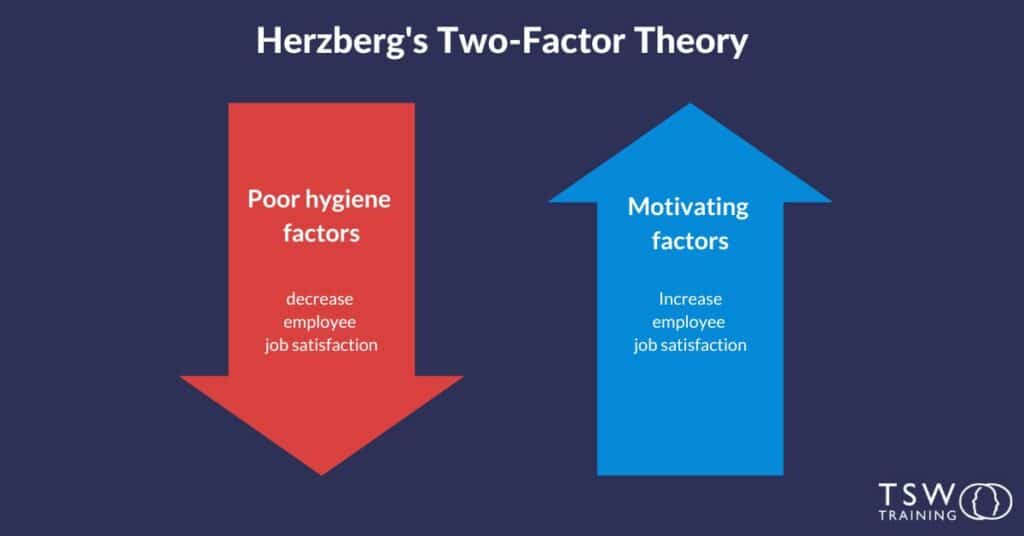How can you motivate your employees to do what you want? Make sure they’re satisfied at work with Herzberg’s two-factor theory.
⏰Key points:
- If your workplace is suffering from low morale, high wages, mistakes, high absence rates and resignation after resignation, it will become an expensive problem for you to solve.
- Herzberg’s two-factor theory will help you to improve morale and attitude, boost attendance and attrition, and keep everyone focused and working as a team.
- It gives leaders and managers the tools to identify and remove the factors that make you feel dissatisfied at work, and to improve factors that make you satisfied at work.
What is Herzberg’s theory of motivation?
The theory of motivation, or two-factor theory created by Psychologist, Frederick Herzberg, is about magnifying employee satisfaction. It helps you to amplify workplace mood, all in the name of improving performance.
The theory helps you identify characteristics in your workplace, and label them:
- Factors that make people feel satisfied
- Factors that make people feel dissatisfied
Our Head of Leadership and Management, Andrew Wallbridge, explains in detail:
“The symptoms and consequences of workforce inertia are sometimes only visible from the top down, but felt bottom up.”
“You might witness an influx of low employee attitude surveys, with few or disparaging responses. Alternatively, low morale, and high levels of sickness and attrition rates might be an unshakable theme in your management meetings.”
“However, managers can see it in their teams and on the floor too. Their people are distracted and unfocused and seldom go the extra mile. They might say: ‘Anything I do to try and motivate seems to miss the mark‘. It’s all evidence of poor employee satisfaction. What can you do about it?”
“Awareness is the key for diagnosing mass employee dissatisfaction and that relies on two-way communication, between managers and leaders.”
“The temptation to attack the problem, or have a knee-jerk reaction, without reward is understandable, ‘Do it because I say so! Improve because we have to!’ but it doesn’t solve the issue.”
“Herzberg’s approach is about tapping into positive motivation, using rewards and incentives to awaken motivation in your people.”
“He describes a pull and a push. You, as the leadership team, are motivated to change to improve performance, but your employee is the one who must move to make it happen. How can you make them move, if they are not motivated?”
Motivational and Hygiene factors
In Herzberg’s theory, the factors can have the same impact on every worker, regardless of the industry, workplace or role.
But we know that what motivates you to leap out of bed in the morning might make your colleague pull the duvet back over their head, so how can every worker be tarred with the same brush?
Herzberg’s factors can be universally (and confidently) applied by managers because they were established and created as part of an in-depth study.
Herzberg’s study
Herzberg collected data about the types of behaviour and cultures that engaged, or disillusioned workers over 12 investigations, from a sample of 1,685 manufacturing supervisors, food handlers, technicians, accountants, engineers and many other professionals.
He asked each person about the job events that led to extreme satisfaction or dissatisfaction, to establish the following factors:[1]
Factors for Satisfaction
- Achievement
- Recognition
- The work itself
- Responsibility
- Advancement
- Growth
Factors for satisfaction are called motivators.
Factors for Dissatisfaction
- Company policies
- Supervision
- Relationship with supervisor and peers
- Work conditions
- Salary
- Status
- Security
Factors for dissatisfaction are called hygiene factors.
According to Herzberg’s findings, job satisfaction and dissatisfaction aren’t opposites.
“The opposite of job satisfaction is…no job satisfaction,” he wrote, “and similarly, the opposite of job dissatisfaction is… no job dissatisfaction.”
In other words, both sets of factors can exist. By eliminating the dissatisfying factors, it won’t automatically improve the satisfying factors. Both need equal attention.
💡Example: Flexible working
For example, let’s consider a post-pandemic management problem. Your company does away with office-based working policies to pursue an altogether more flexible working pattern, but your employees will still have no job satisfaction if they aren’t recognised for their achievements while working from home. Resignations continue.
Herzberg also recorded that some events overlapped satisfaction and dissatisfaction, for example, achievement can be negative ( “I was unhappy because I didn’t do the job successfully”), or a restructure can be positive ( “…the company reorganised the section so that I didn’t report any longer to the guy I didn’t get along with” ).
Andrew explains further:
“Herzberg’s two-factor theory helps you to remove the factors that make your people unhappy and unmotivated. Once the dissatisfiers are in-hand, only then should you ramp up the factors that bring them joy, independence and fulfilment at work.”
“All improve your performance and bottom line. If any dissatisfiers are left unchecked, any efforts to focus on the satisfiers will have no effect.”
Herzberg demonstrated, through his findings, that the attitude of the workforce has a profound impact on performance. It can be costly for your business if the hygiene factors, like micromanagement and lack of development, are allowed to thrive unmoderated.
With the factors defined, Herzberg recommended that managers pursue job enrichment, an effort that would allow for employee’s psychological growth, which could be achieved through vertical job loading.
What is vertical job loading?
Vertical job loading is a skill-building exercise. Managers give their employees more work and with it, extra responsibilities, and autonomy.
Herzberg reveals the principles of vertical job loading in his ground-breaking essay, “One more time: How do you motivate employees?“, all of which motivated employees by rewarding them with responsibility, achievements, recognition, growth and learning.
Here are just a couple of examples:
- Removing controls while retaining accountability gave a worker responsibility and personal achievement
- Increasing accountability for individual’s work gave them greater responsibility and recognition
- Introducing workers to new and more difficult tasks gave them the opportunity to grow and learn
What changes would you expect to see after vertical job loading?
Herzberg’s describes a job enrichment experiment that restructured several worker’s roles, but didn’t seek to resolve the negative hygiene factors in a workplace.
It proved that the people benefiting from vertical job loading outperformed those whose attitude was not influenced by benefits like recognition, achievement, or growth.
In a shareholder service index, which measured the performance of these workers, looking at the quality of letters, information accuracy, and speed of response, Herzberg recorded a performance hike exclusively among the workers who were benefitting from job enrichment and satisfaction.
It was a big leap, rocketing from roughly 25% to 95% just three months after they assumed new responsibilities.[2]
Herzberg surveyed these vertically loaded workers and their attitude towards their job was much improved, thanks to the job satisfaction factors.
How to apply Herzberg’s two-factor theory to improve motivation
There are five ways to get started with Herzberg’s theory of motivation:
#1. Try listening
If your employee engagement and satisfaction surveys are poor, read for the details. Organise 1-2-1s with poorly performing departments and ask specific questions about their desire for more responsibility, accomplishments, training, recognition, promotion and growth.
Listen for hygiene complaints too because as we’ve learned, just remedying satisfaction will not improve dissatisfaction.
#2. Start from the bottom up
Make a list of the job roles that have very low job satisfaction, where performance can be obviously improved, and roles can be practically and inexpensively enriched with satisfaction factors.
#3. Get the balance right of feedback and recognition
Regular feedback through one-to-ones, reviews, evaluation and mentoring sessions give workers direction and purpose. They’re working towards something, and thanks to your thoughtful feedback, constantly improving.
Building relationships between workers and managers will help increase productivity and quality and reduce staff turnover. People want to stay and do well.
Aside from Herzberg, there are several techniques you could use to keep them motivated, including:
#4. Don’t tolerate poor performers – others will see it
Your company is only as good as its poorest performers, so you must do all you can to raise low standards, not let high standards sink.
Poor performers can affect employee morale, influence workplace culture, increase the stress placed on those picking up the work, that hacks away at motivation and commitment.
The feedback and recognition sessions you have with every employee will help you to isolate and diagnose poor performance.
- Is it caused by dissatisfaction?
- Is it an ability barrier?
- Are there distracting external factors?
In any case, give yourself actions to improve their performance, and communicate with the people it directly affects so they aren’t impacted by poor performance.
#5. Make sure people have the tools to do the job – information, skills, resources
You can give people the autonomy and responsibility to challenge themselves and achieve more, but you want them to fly, not fall. Plan their time and resources, give them the skills to move forward productively and measure their achievements.
[1] 1,753 factors characterising events on the job that led to extreme satisfaction, and 1,844 factors characterising events on the job that led to extreme dissatisfaction, One more time: How do you motivate employees?, Fredrick Herzberg
[2] One more time: How do you motivate employees?, Fredrick Herzberg








